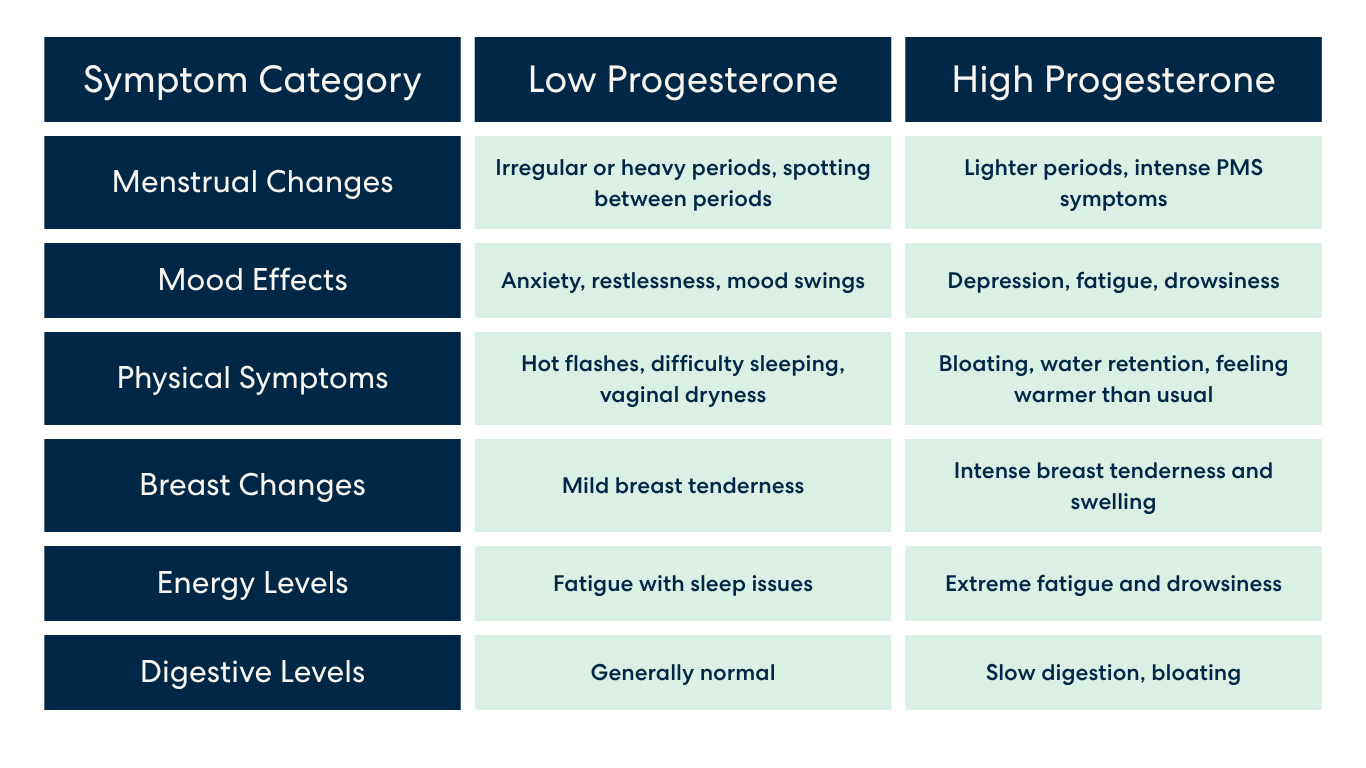Both types of progesterone imbalances can lead to a range of physical, emotional, and cycle-related symptoms. So how can you tell the difference between high vs. low progesterone? Here’s your go-to guide.

Both types of progesterone imbalances can lead to a range of physical, emotional, and cycle-related symptoms. So how can you tell the difference between high vs. low progesterone? Here’s your go-to guide.
Low progesterone causes irregular periods, anxiety, hot flashes, and difficulty conceiving. High progesterone causes bloating, fatigue, breast tenderness, and mood changes. While some symptoms overlap, understanding the key differences helps you identify which imbalance you're experiencing and when to seek treatment.
Progesterone helps regulate your menstrual cycle and supports pregnancy, and having the right balance is crucial for your overall health. Whether you're trying to conceive or just want to understand your body better, knowing the signs of progesterone imbalance can help you advocate for your health.
Progesterone helps regulate your menstrual cycle and supports pregnancy and having the right balance progesterone is crucial for your overall health. For example, low progesterone can lead to irregular cycles, fatigue, decreased libido and difficulty conceiving. High progesterone naturally occurs during pregnancy, but if you’re not pregnant, it can lead to increased PMS symptoms, irregular periods, and more.
Whether you're trying to conceive or just want to understand your body better, knowing the signs of progesterone imbalance can help you advocate for your health. In this guide, we’ll go over low vs. high progesterone symptoms and what they might mean for you.
What is progesterone?
While progesterone is often referred to as the “pregnancy hormone,” it’s important whether or not you’re trying to conceive. After ovulation, your ovaries produce progesterone to prepare your uterus for potential pregnancy. If fertilization occurs, progesterone continues to rise to help maintain the pregnancy. If no egg is fertilized, progesterone levels drop and trigger your period.
Progesterone is like a conductor in an orchestra, it keeps your cycle in rhythm and your body’s functions working together. When levels are too high or too low, you might notice various symptoms as your body tries to adjust.
Need more detailed information?
- Learn everything about high progesterone symptoms and causes
- Discover how progesterone affects fertility
- Understand what progesterone does in your cycle
What causes progesterone imbalance?
Before we go into specific low vs. high progesterone symptoms, it’s helpful to understand why your levels might become imbalanced in the first place.
Your progesterone levels naturally fluctuate throughout your menstrual cycle—that’s normal and healthy! However, sometimes these fluctuations can become more extreme or irregular than they should be.
What causes low progesterone?
Low progesterone can happen at any stage of your reproductive years. Your body needs several systems to work together to properly produce adequate progesterone, from your brain signaling your ovaries and your ovaries releasing an egg to the remaining follicle (also known as the corpus luteum) producing the hormone.
If any part of that system is disrupted, it can lead to lower progesterone levels.
Causes of low progesterone include:
- Anovulation: these are cycles when you don’t ovulate. Without ovulation, the corpus luteum doesn’t form, which leads to low progesterone production. There are multiple reasons for anovulatory cycles, from stress and excessive exercise to polycystic ovarian syndrome (PCOS) and luteal phase defect.
- Polycystic ovarian syndrome (PCOS): this is a condition that causes hormone imbalances (including progesterone imbalances) that affect ovarian function.
- High levels of stress: prolonged periods of stress can interfere with your body’s hormone production and regulation. Stress triggers the release of cortisol, which can affect your body’s progesterone receptors.
- Hormone imbalances: fluctuations in other hormones can impact your progesterone levels. For example, estrogen dominance, where estrogen is higher than other hormones, can lead to lower progesterone levels.
- Age-related changes: As you approach perimenopause, progesterone production naturally declines.
Oova’s hormone test kit can help you understand your hormone levels and whether you have low progesterone. These results can be shared immediately with your provider to help you understand why you may have low progesterone and how to navigate this imbalance.
What causes high progesterone?
Low progesterone may be a more common worry, but high levels of progesterone can also affect your health and how you feel. Some causes of high progesterone are totally normal and healthy like pregnancy, while others might signal that something needs attention.
Causes of high progesterone include:
- Pregnancy: during pregnancy, progesterone levels rise to help maintain the pregnancy and support fetal development.
- Hormonal birth control: some types of birth control contain synthetic progesterone called progestin, which can increase progesterone levels over time.
- Congenital adrenal hyperplasia (CAH): CAH is a rare inherited genetic disorder that affects your adrenal glands, which control hormone production. When you have CAH, your body is missing certain enzymes it needs to produce hormones, which can lead to either too high or too low hormone levels.
- Ovarian cysts: Ovarian cysts, particularly ones that grow on the corpus luteum, can produce high levels of progesterone and estrogen. These are usually harmless, but may grow large enough that they interfere with your body’s natural functions and need to be removed.
Low progesterone vs. high progesterone symptoms
Understanding the difference between low vs. high progesterone symptoms can be tricky because some of these symptoms overlap — not only with each other, but also with other hormonal imbalances or health conditions!
First, let’s start with how and when these symptoms show up during your cycle. With low progesterone, you’ll often notice symptoms throughout your cycle, and they may be most noticeable after ovulation when progesterone should be highest. With high progesterone, you’ll likely notice symptoms throughout your cycle, but they might be most noticeable in your luteal phase and feel similar to intense PMS symptoms.

Low progesterone symptoms include:
- Anxiety or mood changes
- Breast tenderness
- Difficulty getting or staying pregnant
- Difficulty sleeping
- Headaches or migraines
- Hot flashes
- Irregular or heavy periods
- Spotting between periods
- Vaginal dryness
- Weight gain
High progesterone symptoms include:
- Acne breakouts
- Bloating and water retention
- Breast tenderness
- Changes in appetite
- Changes in body temperature (usually feeling warmer than usual)
- Fatigue or drowsiness
- Mild dizziness
- Mood changes or depression
- More frequent urination
- Slow digestion
Key differences in low vs. high progesterone symptoms
Now that you have a whole list of symptoms of each imbalance, what are the similarities and differences?
- Menstrual symptoms: low progesterone typically causes irregular or heavy periods, while high progesterone might make your periods lighter, but cause more PMS symptoms.
- Mood effects: Low progesterone tends to cause anxiety and restlessness, while high progesterone is more associated with feelings of depression and fatigue.
- Physical symptoms: While both can cause breast tenderness, high progesterone typically causes more intense breast changes and bloating. Low progesterone is more likely to cause hot flashes and sleep disturbances.
Progesterone imbalance symptoms: how to find relief
If you’re experiencing symptoms of low vs. high progesterone, there are steps you can take to find relief.
Tracking your symptoms
Tracking your symptoms throughout your cycle can help you identify patterns. Some symptoms might appear cyclically, while others might be more constant.
Low progesterone symptoms might be consistent throughout your cycle or worsen as you approach your period. High progesterone symptoms typically intensify after ovulation and improve once your period starts.
Track both your hormone levels and symptoms from the comfort of your own home with Oova. The Oova Kit tracks your progesterone throughout your cycle, giving you quantified daily data instead of guesswork. You'll see exactly when progesterone rises after ovulation, whether it's in a healthy range, and how it correlates with your symptoms. Unlike generic apps that assume you're "average," Oova learns YOUR unique hormone patterns, essential for anyone with irregular cycles, PCOS, or perimenopause.
Lifestyle changes
Lifestyle changes can also help you regulate uncomfortable progesterone imbalance symptoms, like:
- Maintaining a regular exercise routine (but avoiding over-exercising)
- Practicing stress-reduction techniques
- Getting adequate sleep
- Eating a balanced diet rich in nutrients
- Reducing caffeine intake
- Staying hydrated
When to see a healthcare provider
You may want to consider seeing a healthcare provider if:
- Symptoms are severe or interfering with daily life
- You're having trouble conceiving
- You have very irregular periods
- You experience frequent spotting
- You have concerns about your hormone levels
Tracking your symptoms and sharing this information with your healthcare provider can help determine the best course of action.
Get Answers, Not Guesses
If you're experiencing symptoms of progesterone imbalance, the first step is understanding your symptoms and how they are fluctuating. The Oova Kit helps you track:
- Daily quantified progesterone measurements (not just "high" or "low")
- Personalized insights based on YOUR cycle, not generic averages
- Data you can share with your doctor for faster diagnosis
- Tracking over time to monitor if lifestyle changes or treatments are working
Whether you're dealing with anxiety and irregular periods or bloating and fatigue, Oova helps you identify if progesterone imbalance is the cause and gives your healthcare provider the data they need to help you.
Low vs. high progesterone symptoms: the bottom line
Progesterone plays a vital role in your reproductive health, and imbalances can affect how you feel throughout your cycle.
While some variation in progesterone levels is normal, persistent symptoms might indicate an underlying issue that needs attention. If you're concerned about your progesterone levels, tracking your symptoms and working with a healthcare provider can help you develop an appropriate treatment plan.
Whether your progesterone levels are high or low, understanding your symptoms and how they relate to hormonal fluctuations is key. With proper support and treatment, many people with progesterone imbalances can find ways to manage their symptoms effectively.
Frequently Asked Questions
How do I know if my progesterone is low or high?
The only way to know for certain is through testing via blood tests from your healthcare provider or at-home hormone testing with Oova. Symptoms alone can't definitively diagnose an imbalance since many overlap with other hormonal conditions.
What's the main difference between low and high progesterone symptoms?
Low progesterone causes anxiety, restlessness, and irregular or heavy periods. High progesterone causes fatigue, drowsiness, and lighter periods with intense PMS symptoms like bloating.
Can stress cause low progesterone?
Yes, chronic stress almost always lowers progesterone because your body prioritizes making cortisol over progesterone. High cortisol levels also interfere with progesterone receptors and can disrupt ovulation.
Can I have low progesterone and still get pregnant?
Yes, but it may be more challenging and there's an increased risk of early miscarriage. Many people with low progesterone successfully conceive with treatment like progesterone supplements or ovulation medications.
How long does it take to balance progesterone levels?
It depends on the cause and treatment—progesterone supplementation may improve symptoms within 1-2 cycles, while lifestyle changes typically take 3-6 months. Treating underlying conditions like PCOS may take 6-12 months.
Can perimenopause cause low progesterone?
Yes, perimenopause is one of the most common causes because ovulation becomes less consistent and the corpus luteum produces less progesterone. This commonly causes heavier periods, worsening PMS, sleep issues, and increased anxiety.
About the author

Sources
- Cleveland Clinic. (2024). Progesterone. https://my.clevelandclinic.org/health/articles/22434-progesteron
- Garrett, Anna. (2024). The Cortisol Connection to Perimenopausal Hormone Imbalance. https://www.hormonesbalance.com/articles/cortisol-progesterone-connection/
- Kassel, Gabrielle. (2023). Why Do Birth Control Pills Contain Progesterone? Healthline. https://www.healthline.com/health/birth-control/why-do-birth-control-pills-contain-progesterone
- Nagy, B., et al. (2021). Key to Life: Physiological Role and Clinical Implications of Progesterone. International Journal of Molecular Sciences, 22(20), 11039. https://www.ncbi.nlm.nih.gov/pmc/articles/PMC8536935/
- Prior JC. (2023). Progesterone for treatment of symptomatic menopausal women. Climacteric, 26(2), 128-133. https://pubmed.ncbi.nlm.nih.gov/36847802/
About the Oova Blog:
Our content is developed with a commitment to high editorial standards and reliability. We prioritize referencing reputable sources and sharing where our insights come from. The Oova Blog is intended for informational purposes only and is never a substitute for professional medical advice. Always consult a healthcare provider before making any health decisions.

.jpg)

